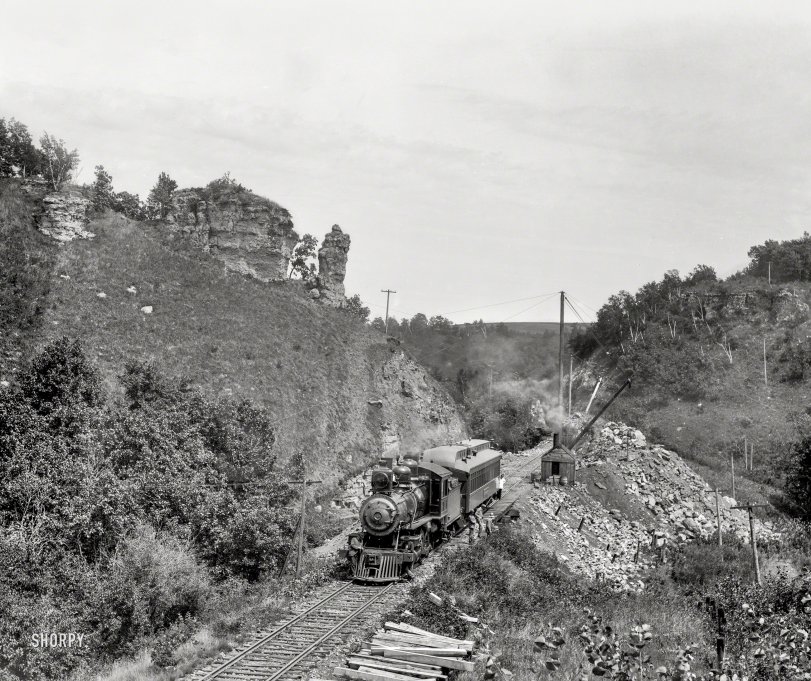


Framed or unframed, desk size to sofa size, printed by us in Arizona and Alabama since 2007. Explore now.
Shorpy is funded by you. Patreon contributors get an ad-free experience.
Learn more.

- Baldwin 62303
- Baldwin VO-1000
- Cold
- No expense spared
- Tough Guys
- Lost in Toyland
- And without gloves
- If I were a blindfolded time traveler
- Smoke Consumer Also Cooks
- Oh that stove!
- Possibly still there?
- What?!?
- $100 Reward
- Freeze Frame
- Texas Flyer wanted
- Just a Year Too Soon
- WWII -- Replacing men with women at the railroad crossing.
- Yes, Icing
- You kids drive me nuts!
- NOT An Easy Job
- I wonder
- Just add window boxes
- Icing Platform?
- Indiana Harbor Belt abides
- Freezing haze
- Corrections (for those who care)
- C&NW at Nelson
- Fallen Flags
- A dangerous job made worse
- Water Stop
Print Emporium
The Pulpit: 1899

Circa 1899. "Near Lewiston, Minnesota -- The Pulpit." Yet another rock formation with a fanciful name. 8x10 inch dry plate glass negative. View full size.
C&NW Business car 104
The open platform car was leased (owned?) by the Detroit Photographic Company.
Special Train followup.
Responding to SouthBendModel34--The Chicago & North Western (C&NW)line through Lewiston I believe started life as the Winona & St. Peter Railroad which had a close association with the C&NW. Note the C&NW logo on the front of the smoke box of number 148. Construction was started about 1866 and the C&NW purchased the railroad in about 1867 though it operated it as a separate entity until 1900. The railroads shared motive power designs and classification codes though motive power , numbering and logos on locomotives were kept separate until the final merger.
Pulpit
The cave on the right is a legend about it being the Devil's Hole. (see photo)
[The photo you attached related to the Lewiston in New York state, not Minnesota. -tterrace]
[Thanks. Being a Brit, I don't know my NY from my MN...]
Locomotive 118
The number plate at the center of the locomotive smokebox seems to read 118.
The line through Lewiston MN is currently the Dakota, Minnesota & Eastern, which is a successor to the Chicago and Northwestern Railway. (Which may or may not have constructed this line: can any Shorpy Sleuth come up with a construction date for the RR through Lewiston MN?
The trestle fill-in would probably be not too long after the opening of the line.
Can photo enhancement read a RR name on the side of the tender, or the name of the single passenger car? (Which is probably the RR's Business Car. This looks like an inspection trip to check on the progress of the trestle fill.)
There's curved, raised lettering on the locomotive smokebox which I would guess to be the name of the locomotive. builder. Can that be enhanced ?
[Signs on the tender and car aren't legible. -tterrace]

Special Train?
The engine is a Chicago & North Western S-2 class 4-6-0 built in 1890. As such it was an example of the biggest and best the railroad had before 1900. The engine lasted until 1925 when it was scrapped. In this photo it hauls one passenger car--an attendant appears looking out from behind the car suggesting a very special train. Perhaps top management. Perhaps an inspection train. The locomotive is a good deal more powerful than needed for one passenger car--an ornate at that.
Filling in a trestle.
It was common practice when these rail lines were built to erect trestles over low places and when the line was completed and in service go back and fill in around the trestle. This is a good picture of that being done.
Karst Topography
I'd like to have a look in that cave on the right.
Does anyone know if the Pulpit still exists?
Link and Pin Coupler
That locomotive is equipped with a primitive Link and Pin coupler. You can see a link hanging from the pin, plain as can be. This is a dangerous manual coupling system that exposed RR workers to dismemberment and death.
There is no air brake hose visible, either.
The 1893 railroad safety appliance act made automatic couplers and air brakes mandatory. It was phased in over seven years, so the actual date of the photo is most likely before 1899 and certainly is not after 1900.
























On Shorpy:
Today’s Top 5